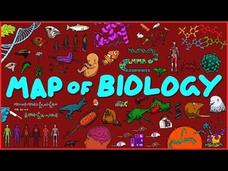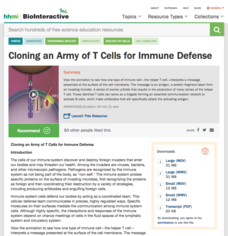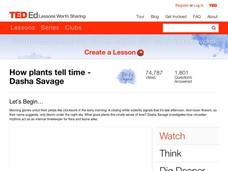Curated Video
Houston We Have a Podcast: Water Bears in Space
Thomas Boothby, assistant professor for the Department of Molecular Biology at the University of Wyoming, teaches us about tardigrades, more commonly known as water bears, that are headed up to the International Space Station for a...
TED-Ed
TED-Ed: How CRISPR lets you edit DNA - Andrea M. Henle
Explore the science of the groundbreaking technology for editing genes, called CRISPR- Cas9, and how the tool could be used to cure diseases. -- From the smallest single-celled organism to the largest creatures on Earth, every living...
The Royal Institution
Jim Al-Khalili - Quantum Life: How Physics Can Revolutionise Biology
In this Friday Evening Discourse at the Royal Institution, Professor Jim Al-Khalili explores how the mysteries of quantum theory might be observable at the biological level. Although many examples can be found in the scientific...
Curated Video
The molecular mechanism of cell division
The Royal Society's journal Open Biology has published an article which studies the structure and function of the protein Syndapin which is involved in cell division. This work will shed light on cellular defects known to occur in cancer...
The Royal Institution
The Rules that Govern Life on Earth - with Sean B Carroll
You can also listen to this event on our new podcast! List here, or searh 'Ri Science Podcast' in your app of choice: https://soundcloud.com/royal-institution/sets/ri-science-podcast Evolutionary biologist Sean B Carroll reveals how a...
Curated Video
Animation: The Central Dogma
The 'Central Dogma' of molecular biology is that 'DNA makes RNA makes protein'. This animation shows how molecular machines transcribe the genes in the DNA of every cell into portable RNA messages, how those messenger RNA are modified...
Stated Clearly
What is a gene?
Support Stated Clearly on Patreon: https://www.patreon.com/statedclearly You've probably heard about GMOs or Genetically Modified Organisms but what exactly is a gene and what does it mean to modify the genes of a plant or animal? We...
AsapSCIENCE
Why Your Body Is AMAZING!
Our bodies are pretty incredible, here's why! Your Body Is Amazing Pt. 3 https://youtu.be/6_Qnc_P1xMQ Your Body Is Amazing Pt. 2 https://youtu.be/g9oCOSvYkWc SUBSCRIBE! It's free: http://bit.ly/asapsci Follow us @whalewatchmeplz &...
Curated Video
Royal Society report 'People and the Planet' - Sir John Sulston FRS
Royal Society calls for a more equitable future for humanity Consumption levels between developed and developing nations must be rebalanced alongside a stabilisation of the world's population by voluntary methods, according to a new...
Curated Video
Why Carrots Taste Sweeter In Winter
UCLA's Liz Roth-Johnson explains why carrots have more sugar when it's cold outside. Because plants are immobile, they must develop defense techniques against predators and the severe cold in winter. For example, carrots have developed...
AsapSCIENCE
Amazing Earth Facts To Blow Your Mind
We live in a beautiful world, and these amazing facts will blow your mind. Subscribe, it's free! http://bit.ly/asapsci What If Humans Disappeared? https://youtu.be/guh7i7tHeZk Created by: Mitchell Moffit and Gregory Brown Written by:...
Curated Video
NASA in Silicon Valley: NASA in Silicon Valley Live - Genius Space Hacks
In this episode streamed on Sept. 13, 2018, we talk about studying life in space. Plus, we share some genius space hacks for doing life science research on Earth and aboard the International Space Station.
Curated Video
Biotechnology in Medicine
It explains various applications of biotechnology in medicine including insulin production, gene therapy and molecular diagnosis
TED-Ed
TED-Ed: Can steroids save your life? | Anees Bahji
Steroids: they're infamous for their use in sports. But they're also found in inhalers, creams to treat poison ivy and eczema, and shots to ease inflammation. The steroids in these medicines aren't the same as those used to build muscle....
Curated Video
How mitochondrial diseases are inherited
In this video, Professor Rob Lue explains how mitochondrial diseases are inherited and discusses the threshold effect and its implications for mitochondrial disease inheritance. *** Sign-up for the course “Cell Biology: Mitochondria” on...
Stated Clearly
Can Science Explain the Origin of Life?
Support Stated Clearly on Patreon: https://www.patreon.com/statedclearly Darwin's theory of biological evolution helps us understand how simple life forms can give rise to complex lifeforms, but how did the first reproducing creatures...
Curated Video
Make The Best Pie Ever Using Science
You may have Grandma’s recipe for the perfect crust, but do you really know what goes on at a molecular level? Subscribe! http://bit.ly/1fUWHyY What Does A Cancer Cell Look Like?: https://youtu.be/BhAP6IfykEQ UCLA biophysicist Amy Rowat...
Domain of Science
The Map of Biology
Many define biology as the study of life but can't agree on a definition of life. Trying to explain all of the domains and subdomains of biology seems a bit easier than defining life. See a full map of the topics covered by the general...
TED-Ed
What Is the Biggest Single-Celled Organism?
Meet Caulerpa taxifolia, believed to be the largest single-celled organism in the world. How does it work and where is it found? Learn all about this invasive algae and why it is so successful.
Howard Hughes Medical Institute
Cloning an Army of T Cells for Immune Defense
How do bodies fight infections and illnesses? An animation of the way T cells clone to fight an infection provides many details. The resource also provides an excellent written introduction and ideas for how to ensure pupils understand...
Howard Hughes Medical Institute
Molecular Basis of Late Ltp (Long-Term Memory)
Scholars compare and contrast the molecular changes for short-term and long term-memory with the help of animated videos. Viewers see the chemical process that changes the brain and stores memories thanks to dopamine.
Howard Hughes Medical Institute
Molecular Basis of Early Ltp (Short-Term Memory)
Digital amnesia: forgetting information one easily finds online. Learn how our brains move information into short-term memory at the molecular level with a short animation sure to make a memorable impression. Viewers observe a synapse...
Howard Hughes Medical Institute
The Mammalian Molecular Clock Model
Animals don't read clocks, so how do they know when it is time for eating, sleeping, and other cyclical needs? Viewers watch an animation of the genes and the molecular clocks inside most mammals. They compare the difference in wild...
TED-Ed
How Plants Tell Time
Can someone really have a "biological clock"? Discover why many organisms on earth have an inherent awareness of where they are in the day's cycle.This video discusses animal adaptations, the earth's revolutions, and how light and...





















